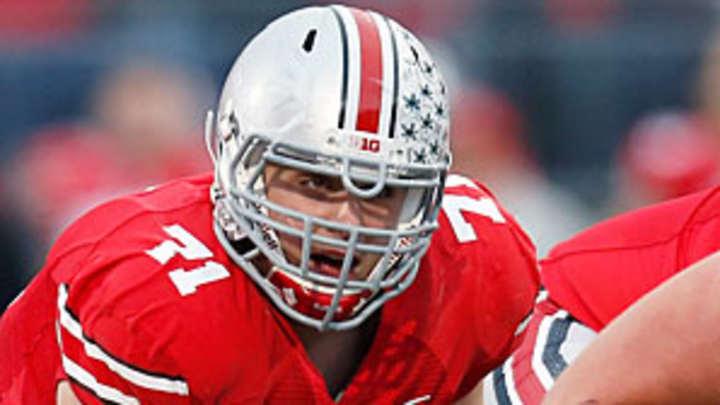Leaner, more disciplined offensive line helps drive Buckeyes' success


At Urban Meyer's first team meeting as Ohio State's coach in January, five offensive linemen didn't show up. At the second meeting, two arrived late. "He looked at me, and I looked at him, and we were like, 'Oh jeez, here we go,'" said Ohio State strength coach Mickey Marotti, Meyer's longtime assistant.
So began the transformation of Ohio State football to fit Meyer's outsized personality, and no group epitomizes that change more than the offensive line. A unit that ranked No. 118 nationally in sacks allowed last year has developed into what Meyer now calls the team's identity.
"They were unmotivated guys," Meyer said. "Obviously, they weren't disciplined. They're our most productive group right now. They're completely different human beings."
The big problem, surprisingly, was that the Buckeyes' offensive line was too big. Meyer and Marotti both used the words "fat" and "sloppy" to describe the physical state of the linemen, part of which stemmed from Ohio State's smashmouth offensive scheme under Jim Tressel. But to play in a drastically higher-tempo spread offense, Meyer needed his linemen leaner, quicker and more disciplined. Along the way, he worked to transform the group's attitude as well.
"The way that they approach their whole world is completely different," Meyer said. "They're energy givers now. They sapped every ounce of energy we had back in January and February. They were overweight, sloppy guys."
Much as he's done with the entire team, Meyer's overhaul with the line has been as much mental as it's been physical. He instilled everything from 4:45 a.m. workouts to an emphasis on healthy eating to a maniacal commitment to strength training. The food has improved, as fridges filled with Gatorade line the complex and a full-time nutritionist works exclusively with football players. Bagels, protein bars and fruit are available in abundance. Last year, players say snacks were scarce; water came from the fountain and the Gatorade machine in the locker room always seemed to be broken.
Quarterback Braxton Miller laughed when recalling the dried-out chicken at the team's training table last year: "We'd be like, 'Man, let's go to Chipotle instead.'"
Former Ohio State linebacker Bobby Carpenter trains in Columbus during the offseason. He said the biggest difference from the Tressel regime comes from Meyer's emphasis on hard work in the weight room.
"There's a high level of accountability on a daily basis to maintain weight and a proper diet and proper nutrition," Carpenter said. "That's something I'd never seen before at the college level."
The results are unmistakable. In the first six months of Meyer's tenure, the team lost 457 pounds of fat and gained 521 pounds of muscle. The offensive line, a group of just a dozen guys, lost a combined 133 pounds of fat. Marotti keeps a binder on his desk that features photographs of the most extreme makeovers -- before-and-after pictures that seem ready for reality TV.
Some, like senior right tackle Reid Fragel, have grown exponentially bigger. He transformed from a 281-pound tight end to a 310-pound tackle in six months, and now Meyer calls him Ohio State's best lineman. Right guard Marcus Hall dropped from 330 to 315 pounds, and his body-fat percentage dipped from 26 to 24. (Marotti would love to get it below 20.)
Center Corey Linsley, who gained 15 pounds and lost three percent body fat, said Meyer used last year's struggles as motivation, harping on the unit's 118th national ranking in sacks allowed. But since the players bought in, Meyer has warmed up to them and built strong personal relationships. Meyer also went out of his way to credit line coach Ed Warinner for an "excellent job."
"We've seen it go from a public humiliation," Linsley said, "to a personal bond we have between us."
There's also a strong bond with Marotti, whose title (assistant athletic director for football sports performance) and salary ($380,000) underscore his value to the program. Marotti generates results largely via the environment he creates, as he's been known to blare music, use quirks like three-plate Thursday and implement various themed lifting days. (There's a Harley Davidson day where the players all dress in black and cut-offs.) "It's not a fun atmosphere, but an entertaining atmosphere," Linsley said. "It makes you want to lift."
Marotti's role can be summed up by one of the few decorations hanging on his office wall. There's a print out of a mock book cover: "My Foot in Your Ass. Dr. Seuss' Wacky Book of Ass Whoopin's."
"The offensive line was brow beaten by the head coach, the offensive line coach and myself from Day 1," Marotti said. "Just the way they looked and how they acted. They've come light years."
And for proof, just look at which team is gasping for breath during the fourth quarter. In their 10-0 start, the Buckeyes have outscored opponents 101-72 over the final 15 minutes of games.
"We see teams getting tired in the fourth quarter," said Linsley. "We don't really know what tired is in a game anymore, that's how well conditioned we are."
Meyer stresses that there is still a ways to go. Only Fragel is slated to leave after the season, and the group -- which includes left tackle Jack Mewhort and left guard Andrew Norwell -- figures to be one of the program's pillars next year.
There's more conditioning to be done. But if the group's progress from last winter is any indication, the offensive line will shape up just fine.
"I wouldn't call them chiseled," Meyer said, "but they're my favorite group of players to be around."
